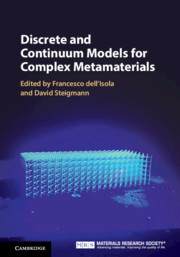Book contents
- Frontmatter
- Contents
- List of Contributors
- Part I Designing Complex (Meta)Materials: Results and Perspectives
- Part II Mathematical and Numerical Methods
- 4 Naive Model Theory: Its Applications to the Theory of Metamaterials Design
- 5 Lagrangian Discrete Models: Applications to Metamaterials
- 6 Experimental Methods in Pantographic Structures
- 7 Variational Methods as Versatile Tools in Multidisciplinary Modeling and Computation
- 8 Least Action and Virtual Work Principles for the Formulation of Generalized Continuum Models
- Index
7 - Variational Methods as Versatile Tools in Multidisciplinary Modeling and Computation
from Part II - Mathematical and Numerical Methods
Published online by Cambridge University Press: 20 February 2020
- Frontmatter
- Contents
- List of Contributors
- Part I Designing Complex (Meta)Materials: Results and Perspectives
- Part II Mathematical and Numerical Methods
- 4 Naive Model Theory: Its Applications to the Theory of Metamaterials Design
- 5 Lagrangian Discrete Models: Applications to Metamaterials
- 6 Experimental Methods in Pantographic Structures
- 7 Variational Methods as Versatile Tools in Multidisciplinary Modeling and Computation
- 8 Least Action and Virtual Work Principles for the Formulation of Generalized Continuum Models
- Index
Summary
To get predictions from theoretical models of complex mechanical systems, the numerical tools are essential, as very few results can be obtained using analytical methods, especially when large deformations are involved. Variational methods are the preferred (or probably the most powerful) tool to formulate the numerical codes to be used, also in the study of metamaterials. A presentation focused on some aspects of numerical techniques, relevant to the considered class of problems, is presented.
- Type
- Chapter
- Information
- Discrete and Continuum Models for Complex Metamaterials , pp. 298 - 326Publisher: Cambridge University PressPrint publication year: 2020

